2024年度
2023年度
2022年度
2021年度
2020年度
2019年度
2018年度
2017年度以前
講演会(2024年度)
「ダイバーシティとマジョリティ/マイノリティと特権と交差性(インターセクショナリティ)のさらなる理解について」(終了しました)
|
開催日 2025年
会 場 西3号館 コミュニケーションスクエアⅡ(108号室) |
[講演者] DV加害者教育プログラム(NOVO)運営者/立命館大学大学院非常勤講師伊田 広行 氏
[プロフィール] 大学でジェンダー論等を担当するかたわら、各地でDV/デートDV(ストーカー)防止教育をしている。また、大阪でDV加害者教育プログラム(NOVO)を運営している。 シングル単位論に加えて、最近は、主流秩序論を展開し、根本的な改革を提起している。2024年度中に、15冊の「主流秩序観点によるジェンダー論講義録」を出す予定。 主な著書に『「DVと虐待」対策・改善提言2020』(Kindle, オンデマンド印刷書籍、2020年3月発行)、『シングル単位思考法でわかる デートDV予防学』(かもがわ出版、2018年)、『閉塞社会の秘密──主流秩序の囚われ』(アットワークス、2015年4月)など。
[概要] 現代日本社会では、多様な人材が活躍するための施策や研修が多くの組織で実施されている。しかし、ダイバーシティ概念の広がりとともに、マジョリティとマイノリティや、様々な違いに基づく分断的様相が生じている。ダイバーシティ概念と分断は本来あいいれないはずである。このような問題状況について、伊田広行氏をお招きし、マジョリティ論のさらなる深い理解と、交差性(インターセクショナリティ)の理解を通して考える機会とすることが本講演会の目的である。
[対象] 和歌山大学の教職員 ※和歌山大学学生と教職員は、録画映像を和歌山大学Moodleで視聴できます(2025年3月31日まで)。
[講演風景]
共 催:ソーシャル・インクルージョン研究ユニット |
「競争の役割と公正取引委員会の活動 ー中小企業・フリーランスの取引環境整備とデジタル分野の取組ー」(終了しました)
|
開催日 2024年
会 場 西2号館 E101 |
[講演者]  公正取引委員会 近畿中国四国事務所長 公正取引委員会 近畿中国四国事務所長片桐 一幸 氏
[略歴] 平成元年 3月 慶應義塾大学経済学部卒業
[概要] (1) 競争政策の意義
[対象] 和歌山大学の学生・教職員
[講演風景]
|
「Energy Resources Management and Sustainable Environment: Lessons from Natural Disasters in Japan and Türkiye」(終了しました)
|
開催日 2024年
会 場 西3号館 305号 |
[講演者]
[略歴] Prof. Dr. Ayfer Gedikli, Düzce University, Türkiye - Coordinator of the International Office, and Former Dean of the Faculty of Political Sciences, Düzce University - Organizer of Several International Conferences, including the International Congress on Energy, Economics, and Security, Conference on Climate Change, Sustainability and International Cooperation, and International Conference on Covid-19, inter alia. - Member of the Editorial Board and Guest Editor at several scientific journals related to Resources Policy, Environmental Quality, Spatial Economic Analysis, and Emerging Economies, among others. - PhD. Degree in Economics, Marmara University, Türkiye
[講演会の概要] The risks of natural disasters such as earthquakes and tsunamis are inevitable, but it is important to draw lessons in order to minimize the damage in terms of human loss and natural degradation. The objective of the presentation by Prof. Dr. Ayfer Gedikli is to share some insights about the challenges posed in reconstructing cities and sustaining energy resources. Most recently, Türkiye experienced the devastating Kahramanmaras Earthquake while Japan is particularly vulnerable to several types of other disasters due to its rugged topography and location in the Pacific earthquake belt, among others.
[対象] どなたでもご参加いただけます(無料)
[講演風景]
|
「経済学から見たレジリエンスの諸相:自然災害と経済危機のケース」(終了しました)
|
開催日 2024年
会 場 西2号館 E105室
|
[講演者]
[略歴] 名古屋大学大学院経済学研究科教授。1960年生まれ,1983年京都大学経済学部卒業,1992年マサチューセッツ工科大学経済学博士(Ph.D.),住友信託銀行,UBC,京都大学,大阪大学,一橋大学を経て2019年より現職。2024年に一橋大学名誉教授。専門分野はマクロ経済学。01年日経経済図書文化賞,07年日本経済学会石川賞,08年エコノミスト賞,11年全国銀行学術研究振興財団賞,12年石橋湛山賞を受賞。14年春に紫綬褒章受章。近著作にStrong Money Demand in Financing War and Peace, Springer,『財政危機とマクロ経済』(名古屋大学出版会)等がある。
[講演会の概要] 主な講演内容は
この講演では、社会と経済のレジリエンスのバランスをどう取るか、効果的な災害対応とリスク管理は何か、といったことに関する深い洞察を得ることができ、大変有意義であった。
[対象] どなたでもご参加いただけます(無料)
[講演風景]
|
「Winning Journal Editors' Hearts and Minds: The Dos and Don'ts」(終了しました)
|
開催日 2024年
会 場 西3号館 3階 第2会議室(305室)
|
[講演者] Dr. Hooi Carol Lai-Wan
[略歴] 2023/06~2023/06 Soochow University Department of Business Administration 教授
・ Institute of Chartered Secretaries and Administrators Company Secretarial 修了 Grad. ICSA
[講演会の概要] Research activities and publications are an integral part of the responsibilities assumed by academicians concerned about the pursuit of knowledge and sharing new ideas. The objective of the presentation by Prof. Dr. Carol Hooi is to provide some insights about the role of journal editors in ensuring the integrity of the process of scientific discovery and research publication with the fundamental principles of sharing knowledge based on independent and objective assessment. The seminar is also aimed at drawing attention to common errors and failures that should be avoided in the submission of research for journal publication and unlock the potential for successful future academic careers. The concerns of journal editors are not limited to the serious issues of plagiarism and simultaneous submissions, but extend also to the fulfillment of minimum requirements and avoidance of shortcomings related to weak motivation, lack of originality, inadequate methodology, misinterpretation of results, and drawing of conclusions inconsistent with prior objectives. These Do’s and Don’ts are important in winning the hearts and minds of journal editors. This is an opportunity for the audience to share thoughts about the ideal goals that younger researchers, in particular, may set at the early stages of their academic career, in terms of the number of periodic paper submissions, journal publications, conferences presentations, and fund solicitations, inter alia.
[対象] 和歌山大学 学生・教職員のみ
[講演風景]
|
2023年度
「競争の役割と公正取引委員会の活動 ~デジタル分野における取組と不当表示規制~」(終了しました)
|
開催日 2023年
会 場 西2号館 E101 |
競争の番人・公正取引委員会が やってくる! [講演者]  公正取引委員会 近畿中国四国事務所長 公正取引委員会 近畿中国四国事務所長原 一弘 氏
[略歴] 平成 4年 3月 早稲田大学政治経済学部卒業
[対象] 和歌山大学の学生・教職員
[講演概要] (1) 競争政策の意義
[講演風景]
|
「長距離フェリー概論~フェリーの社会的役割」(終了しました)
|
開催日 2023年
会 場 オンライン または 西3号館 3F
|
[講演者]
[略歴] 1954年 京都市生まれ69歳 国土交通省港湾局「次世代高規格ユニットロードターミナル検討会」委員
[対象] どなたでもご参加いただけます(無料)
[講演概要] ご講演は、91ページにも及ぶスライドをご準備いただき、
[講演風景]
|
2022年度
最近の競争政策の展開~デジタルエコノミーにおける競争政策を中心に~(リアルタイムオンライン講演は終了しました)
|
開催日 2022年
|
月9ドラマで脚光を浴びている公正取引委員会が語る!! [講演者]  公正取引委員会 近畿中国四国事務所長 公正取引委員会 近畿中国四国事務所長原 一弘 氏
[略歴] 平成 4年 3月 早稲田大学政治経済学部卒業 [対象] 和歌山大学の学生・教職員 [概要] |
Efficacy of remote working in times of the COVID-19 pandemic: Evidence from Taiwan (ROC), Japan and UK(終了しました)
|
開催日 2022年
会 場 西3号館 305室 |
[講演者]
[略歴] 和歌山大学 経済学修士(経営学・人的資源管理)(1996年3月修了) [概要] [対象] 和歌山大学の教職員 ※講演は英語で行われます。
[講演会の風景]
|
2021年度
金融情報サービスにおけるDX(オンライン講演会は終了しました)
|
開催日 2022年
会 場 西2号館 E-101 |
[講演者]
[主催] 和歌山大学 経済学部 イスラム金融研究ユニット [開催協力] 和歌山大学 経済学部 経済総合研究所 [講演会の様子] [概要]
|
デジタルインテリジェンスと電動化技術(オンライン講演会は終了しました)
|
開催日 2022年
会 場 西4号館 T-101 |
[講演者]
[主催] 和歌山大学 経済学研究科(エネルギー・アナリティクス&政策プログラム) [後援] 和歌山大学 経済学部 経済総合研究所 [講演会の様子]
[概要]
|
エネルギーとDX戦略(オンライン講演会は終了しました)
|
開催日 2022年
会 場 西4号館 T-101 |
[講演者]
[主催] 和歌山大学 経済学研究科(エネルギー・アナリティクス&政策プログラム) [開催協力] 和歌山大学 経済学部 経済総合研究所 [講演会の様子]
[概要]
|
日本の金融市場とイスラム金融の現状と課題(講演会は終了しました)
|
開催日 2022年
会 場 西5号館 |
講 演 「マレーシアでのイスラム金融事業と商品」
コメント 「日本のイスラム金融政策」について 挨 拶 和歌山大学 Nabil El Maghrebi 副学長 [講演会の様子]
[概要] |
「最近の競争政策の展開~デジタルエコノミーにおける競争政策を中心に~」
(オンデマンド講演会は終了しました)
|
= 開催期間 = 2021年 |
[ご講演者]
[視聴対象者] [概要] |
2020年度
「競争政策 ~その適用領域の多様性」(オンデマンド講演会は終了しました)
|
2020年 |
公正取引委員会 近畿中国四国事務所長 [視聴対象者] [概要] (2)独占禁止法・公正取引委員会 (3)様々な領域での政策展開 |
2019年度
「Insights into Retail Energy Pricing」(終了しました)
|
2020年 西3号館 第1会議室 |
ニュージーランド、ワイカト大学・ワイカトマネジメントスクール 教授 [概要] 《講演の様子》 |
「THE SUCCESS OF DEMOCRATIC PROCESS IN TUNISIA AND THE ONGOING ECONOMIC CHALLENGES」(終了しました)
|
2020年 東1号館 G-101 |
駐日チュニジア特命全権大使 [概要] 《講演の様子》 |
「Sovereign Retail Sukuk: The Indonesian Experience」(終了しました)
|
2019年 西3号館5階 第1会議室 |
Head of Islamic Economics Department, Faculty of Economics and Business Universitas Airlangga, Surabaya, Indonesia [概要] 《講演会の様子》 |
「競争政策-その適用領域の多様性」(終了しました)
|
2019年 西2号館3階 E302 |
公正取引委員会事務総局 近畿中国四国事務所長 [概要] 《講演会の様子》 |
「Attitude toward tax evasion: A comparative study of France and Japan」(終了しました)
|
2019年 西3号館5階 第1会議室 |
Fayetteville 州立大学(米国・ノースカロライナ州)准教授 《講演会の様子》 |
「日本型経営のインド展開とその課題」(終了しました)
|
2019年 西3号館5階 第2会議室 |
ジャワハルラル・ネール大学日本研究科 教授 《講演会の様子》 |
「鉄道・バス事業の再生事例について」(終了しました)
|
2019年 西3号館5階 第2会議室 |
水間鉄道株式会社 取締役社長 藤本 昌信 氏 [概要] 京福電鉄・京福バス・大阪地下鉄・大阪市バスの再生と民営化について、実務的経営手法をご講演いただきました。 《講演会の様子》 |
2018年度
経済成長と電力需要、発電、LNG
和歌山大学経済学部経済総合研究所設立記念講演会
| 2018年 12月13日(木) |
株式会社JERA代表取締役社長 垣見祐二氏 ポスターはこちら(ダウンロード/PDFファイル) |
 |
中国における職業病防治法の改正
| 2018年 7月25日(水) |
中央司法警官学院(中国河北省) 教授 張 玲(ZHANG LING)氏 ポスターはこちら(ダウンロード/PDFファイル) |
 |
テーマ:「グローバルブランド和歌山」
| 2018年 4月3日(火) |
岩手県立大学総合政策学部 准教授 近藤信一氏 演題:『IoT市場の本質と市場獲得戦略 ―日系電子部品メーカーを対象とするインタビュー調査から―』 ポスターはこちら(ダウンロード/PDFファイル) |
 |





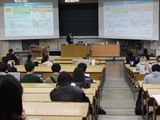
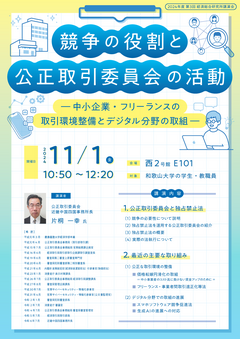

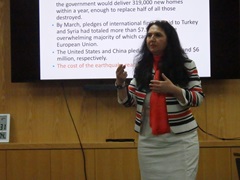
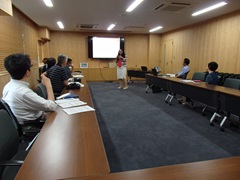
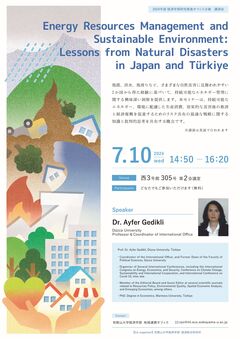

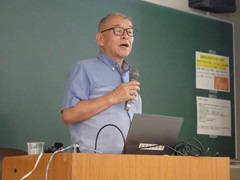
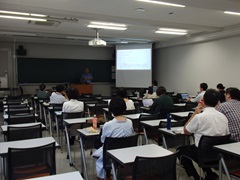
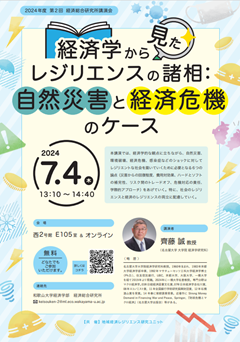

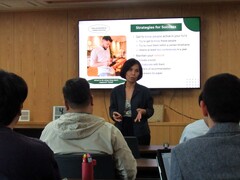
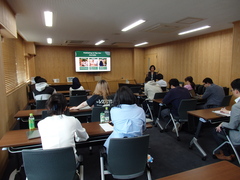
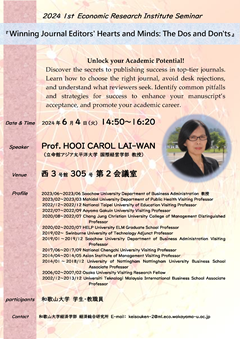
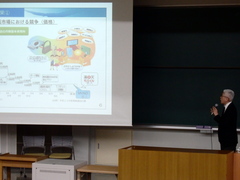
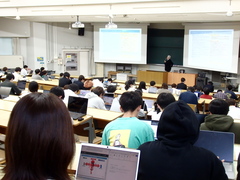


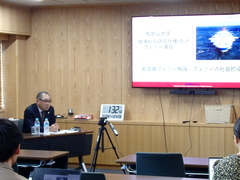
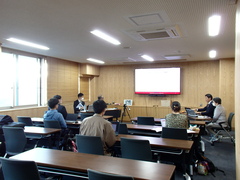













 講演者:
講演者:


 公正取引委員会 近畿中国四国事務所長
公正取引委員会 近畿中国四国事務所長 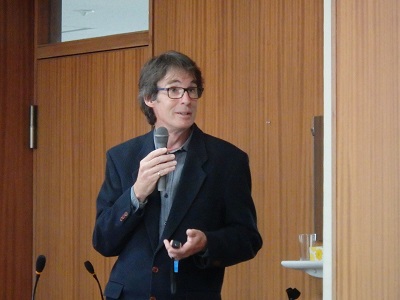
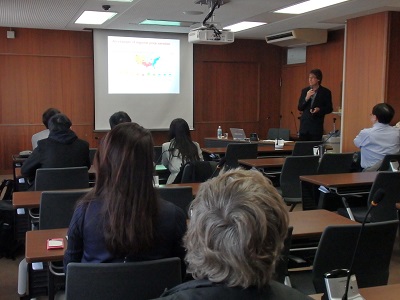
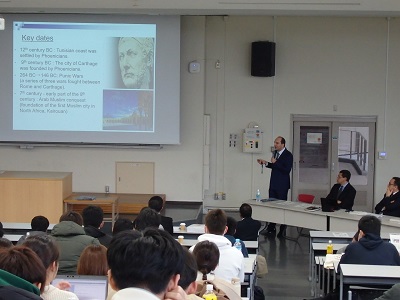

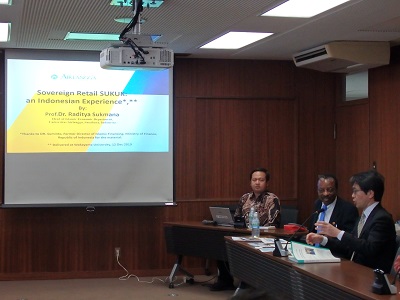
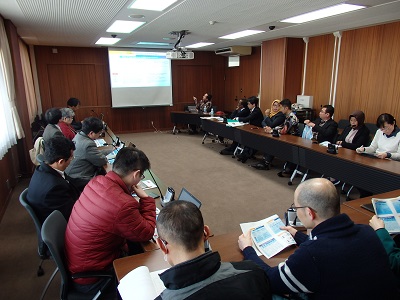
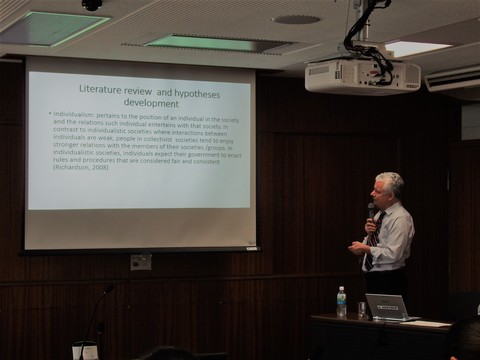
 通常開放日 9:00~17:00
通常開放日 9:00~17:00 閉所日
閉所日